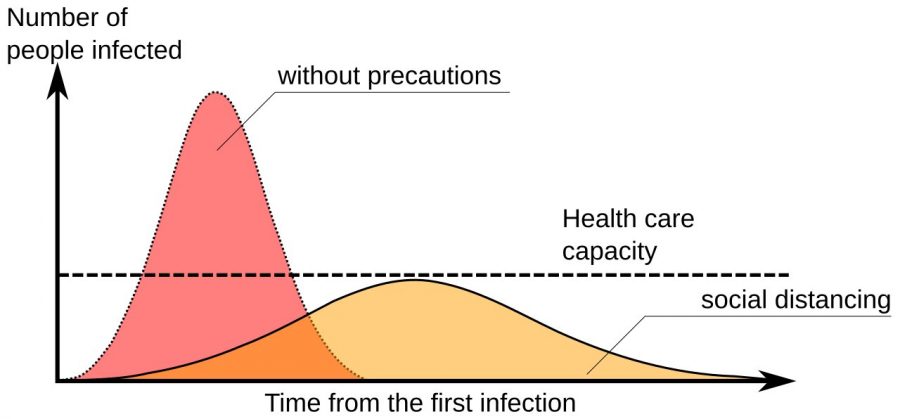Working to flatten the curve
Johannes Kalliauer – Wikimedia
Spatial/Social distancing delays the further spread of a virus and preserves the capacity of the health system.
April 17, 2020
As COVID-19 sweeps the nation, measures have been put in place to slow it’s spread.
According to the World Health Organization, there have been 632,781 confirmed cases and 28,221 deaths in the U.S. as of April 17, 2020, with the number of cases continuing to grow.
With public health and safety in mind, rules such as shelter-in-place and social distancing have been advised nationally and put into effect on local levels to decrease the chances of it being spread through person to person contact.
All locations where large groups of people (considered to be gatherings of between 10-50) gather in close proximity or for prolonged periods of time that have been deemed non-essential have been asked to close temporarily, including adapting schools to online distance learning for the foreseeable future.
These steps have all been taken in hopes that the number of new cases being infected will begin to decrease, thereby “flattening” the near exponential curve that the current data is showing. The phrase “flattening the curve” has been used frequently over the past month, and can be explained through math.
“With a line, you know it will keep going up at the same rate. However, when it comes to the spread of a virus, it has exponential growth, which means it makes a curve instead of a line,” math teacher Kevin Daniels said. “Think of the curve as a “J.” So it is going up, but it goes up faster and faster. For example, if I was going to double a number over and over, it would look like this if it started at 1: 1, 2, 4, 8, 16, 32, 64, 128, 256, 512, 1024. If this was a disease, it started with one person. Then two more were infected. By the time we get to the 10th transfer, we have over 1000 new infections.”
With methods like social distancing taking place, there will eventually be a peak, and the curve will start curving down in the other direction. The curve has not yet reached a peak and will likely continue to grow, emphasizing the importance of limiting exposures and avoiding unnecessary contact with others.
“By slowing the spread, we take that exponential growth, the curve when you graph it, and it slows down,” math teacher Kevin Daniels said. “So ‘flattening the curve’ doesn’t mean nobody gets sick, it means the rate of new infections is slowing down, which gives the health care system more time to treat people properly, which saves lives.”
While students may not fall in the risk groups, they are still susceptible to the virus, and if infected can become asymptomatic individuals who then spread the virus to others they come into contact with after the initial exposure, who’s symptoms then become life-threatening.
By being in close proximity to others within the school, like with any illness it can spread very quickly. That said, what has allowed COVID-19 to spread as it has is the lack of immunity, as it is caused by a new strain in the coronavirus family.
By taking precautions and measures in the community early on, it acts as a preventive to requiring a much larger scale response after the damage has been done. On any given school day, Ritenour High School can have close to 2,000 people in the building, and other schools have large numbers as well, so decisions were made to shut down the physical buildings in order to flatten the curve.
“I think Ritenour has responded extremely well. I do think there are some problems with clarification, which is completely expected because we are in uncertain times. Supporting each other, our families, and our board through this stressful time is what is most important,” Student Board of Education Representative Kayla Baker said. “Many Americans have never experienced anything like this before in their lives. We can be understanding, as well as hold accountability when things don’t go well.”
Ritenour, like all other St. Louis City and County school districts will be closed through the rest of the school year with distance learning continuing until June 2.



